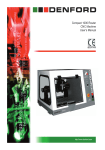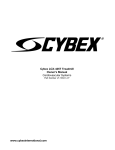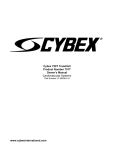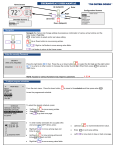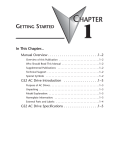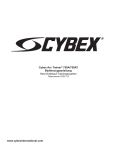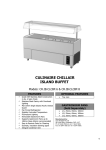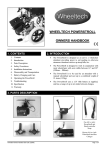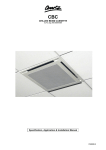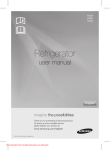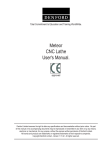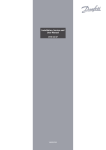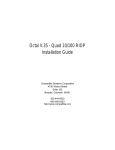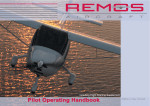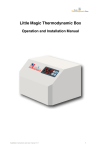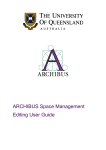Download Vertical router CNC Machine User`s Manual
Transcript
Vertical router CNC Machine User’s Manual approved http://www.denford.com 1 1: Contact Information Address: Telephone: Fax: e-mail: Technical Support: Denford Limited, Birds Royd, Brighouse, West Yorkshire, HD6 1NB, UK. General Enquiries 01484 728000 01484 728100 for sales enquiries contact, [email protected] for machine servicing enquiries contact, [email protected] for customer services, contact [email protected] Support Forum at www.denford.co.uk e-mail: [email protected] Telephone Denford Customer Services: 01484 728000 For international dialling:+44 and remove first 0 in city code Monday to Friday 8.30am - 4.30pm GMT 1: Notes Denford Vertical Router - User manual Page2 Table of Contents 1: Notes Denford Vertical Router - User manual Page 3 1: Contents Preface Page 1: Contact Information ............................................................................................ 2 1: Notes .................................................................................................................. 2 1: Contents ............................................................................................................. 4 1: Warning Notices ................................................................................................. 5 1: About this Manual............................................................................................... 6 1: Introducing your Vertical Router ......................................................................... 7 1: Before Beginning to Setup.................................................................................. 8 Safety 2: Safety Features Overview and Precautions ....................................................... 9 2: Safety Features - Emergency Stop Button......................................................... 10 2: Safety Features - Interlock Guard Switch........................................................... 11 2: Safety Features - Interlock Guard Switch cont................................................... 12 Installation 3: Lifting and moving your CNC machine............................................................... 13 3: Choosing a site for your machine....................................................................... 16 3: Removing Protective Coatings and Packaging .................................................. 17 3: Connecting to the machine ................................................................................ 18 3: Microrouter Electrical Panel................................................................................ 18 3: Dust Extraction & General Wood Precautions.................................................... 19 Machine Control 4: Operators Panel : Axis limit overide ................................................................... 20 4: Front Machine Operators Panel ........................................................................ 21 Tool Change operation 5: Performing a Tool Change.................................................................................. 22 Maintainance 6: Planning Procedure for Maintenance Work........................................................ 24 6: Maintenance Schedule ...................................................................................... 25 7: Maintenance of the Router Motor....................................................................... 26 8: Maintenance Log................................................................................................ 27 Technical Support and Troubleshooting 9: Technical Support ............................................................................................... 29 10: Troubleshooting - Cutting Problems ................................................................. 30 10: Troubleshooting - VR CNC Milling Software..................................................... 31 10: Troubleshooting - VR CNC Milling Tool Offsets................................................ 33 10: Troubleshooting - Mechanical Problems .......................................................... 34 Appendix 11: EC Declaration of Conformity ........................................................................... 35 11: Vertical Router Series Noise Level Test Results............................................... 36 11: Glossary............................................................................................................ 37 12: Notes .................................................................................................. 40 Denford Vertical Router - User manual Page 4 1: Warning Notices Warranty Disclaimer. The Warranty on your Vertical Router will be invalidated if any modifications, additional ancillary equipment is fitted, or any adjustments are made to the controlling devices without prior notification from Denford Limited. Please refer to the information held in your separate Warranty pack, for specific details. Do not carry out any portable appliance testing (PAT) on any of the supplied equipment. Maintenance Disclaimer. Always obtain permission from the person responsible for machinery in your establishment, before accessing the electrical control panel or Vertical Router machine casings to carry out any maintenance work. All work must be carried out by personnel suitably qualified for each maintenance task, to avoid damage to both the machine systems and the maintenance personnel. Denford Limited cannot accept responsibility for any damage and/or loss that may occur through incorrect maintenance of your Microrouter Compact. Foreseen Use of Machine. Your Vertical Router is designed for routing hard and soft woods, certain ceramics and plastics. In each case, the appropriate tooling, speeds and feeds should be used as recommended by the material supplier. Your Vertical Router is not intended for use with any ferrous or metallic materials. Facility is provided for dust extraction. Always use the machine coupled to a vacuum system. Do not attempt to use your Vertical Router for manual operations. Do not remove the router head and attempt to use it independently of the machine. If you have any doubts and/or questions regarding the specification, servicing, or features of your machine, please contact Denford Customer Services. Denford Limited reserves the right to change the specification and/or operating features regarding this CNC machine without notice or documentation. Denford Vertical Router - User manual Page 5 1: About this Manual Using this manual Disclaimer Screenshots Language Contact This manual provides information describing how to transport, site, setup and operate the basic functions of your Denford Vertical Router CNC machine, including any operational features of hardware specific to the Vertical Router series. This manual does not provide any information regarding the software packages used to control your Vertical Router - please refer to the help section in the machine control software. Please note that the Electrical Diagrams for your Vertical Router are not included in this manual - they are delivered separately in the standard equipment box supplied with your CNC machine. If you have any doubts and/or questions regarding the specification, servicing, or features of your Vertical Router, please contact Denford Customer Services. Denford Limited reserves the right to change the specification and/or operating features regarding this CNC machine without notice or documentation. Please note that due to the nature of hardware and software developments, the specifications and features of this product can change without notice. The information contained in this manual is correct at the date of printing only - September 2006. No liability can be accepted by Denford Limited for loss, damage or injury caused by any errors in, or omissions from, the information supplied in this manual. Please note that any screenshots are used for explanation purposes only. Any numbers, wording, window or button positions may be different for the configuration of the CNC machine control software being used to control your Vertical Router. This manual is written using European English. Any comments regarding this manual should be marked for the attention of our technical authoring team and referred to the following e-mail address: [email protected] Denford Vertical Router - User manual Page 6 1: Introducing your Vertical Router Congratulations on your purchase of a Vertical Router series CNC machine. In this manual you will learn how to setup and use your Machine correctly and safely. Your Vertical Router is a full three axes CNC router with a large work area, allowing machining of materials approaching 1380x1040mm in size. Suitable for all levels of education and training, it is manufactured to meet industrial standards. Together with rapid traverse rates of up to 20m/min your Vertical Router is the ideal partner for intensive 3D applications, such as the F1 Team in Schools CAD/CAM Design Challenge (www.f1inschools.co.uk) Land Rover4x4 challenge. Your Vertical Router is designed with you in mind - making the processes involved both safe and easy to use. Main Features: • Designed specifically for Education and Training. • Manufactured to industrial standards. • Programming via International Standards Organisation format, incorporating controls such as FANUC. • CE approved for safety. • Capable of cutting common resistant and prototyping materials, including Wood, MDF, Wax, Plastics and Acrylics. • Links to various CAD/CAM software packages. • Totally enclosed high visibility interlocked guard. • Feedrate override control. • Dust extraction. Denford Vertical Router - User manual Page 7 1: Before Beginning to Setup Before beginning to set up your Vertical Router, please check your separate order documentation, making sure that all items have been delivered to your establishment. Any missing or damaged items should be reported to Denford Customer Services as soon as possible. The following equipment is supplied as standard with your Vertical Router CNC machine (see note left): • Vertical Router CNC machine. Note that the precise specification of your CNC machine will depend on any options selected at the time of ordering (see below). • 1 x Set of Workholding Clamps • 1/4” Collet and 1/2” Collet • 1 x Allen (hex) keys pack. • 2 x Router head spanners. • External USB Cable • 1/4”Dia. Ball Nose Cutter • 1 x Vertical Router warranty pack (UK Machines only) • 1 x CD-ROM containing Denford VR CNC Machine Control Software and manuals, and Machine user’s manual. • 1 x VR CNC Machine Control Software Security Key (dongle) or Flash screen software (supplied on removeable media). The following optional equipment may also be supplied with, or ordered for, your Vertical Router CNC machine: • Additional Software: CAD/CAM, Offline CNC Machine Control. • CNC Machine Control software security keys (dongles) or licence disks. • PC workstation. • Dust extraction unit. • 4th Axis Programmable Rotary Fixture inc. QuickCAM 4D (Site Licence). • F1 in Schools Car Manufacturing Fixture (for both D and R Type Cars) • 4th Axis F1 in Schools Car Manufacturing Conversion Kit • Various tooling packages. • Courseware, project books and project material packages. • Video conferencing system. • Additional and/or on-site training courses. • On-site CNC machine commissioning. Denford Vertical Router - User manual Page 8 2: Safety Features Overview and Precautions Safety Features Overview. The following safety features are standard on your Vertical Router : • • • • Emergency stop button. Manually operated, totally enclosed guard door with interlock switch. Option on control software to check CNC programs using toolpath graphics, prior to machining. Automatic tool retraction and spindle stop for tool changing. Safety Precautions. Safety is very important when working with all forms of machinery but particularly when working with CNC equipment, due to the hazardous voltages, speeds and forces that exist in the hardware. Follow the rules below at all times, when using your Vertical Router. General Safety Precautions : • Wear clothing suitable for machine operation and follow the safe working procedures in place at your establishment. • Do not place any objects so that they interfere with the guards or the operation of the machine. • Never try to clean the machine if any part of it is rotating or in motion. • Always secure the work on the table or in a fixture or vice. • Ensure that the correct cable for the power source is used. • Ensure the mains power is switched off (and preferably unplugged) before starting any maintenance work on the machine. Post a notice informing others not to use the machine since it is undergoing maintenance. • Hazardous voltages can still exist immediately after switching the machine off. Always wait at least 5 minutes before accessing the CNC machine electronics. • If power fails turn off the mains power switch immediately and unplug the machine from the mains power socket. • Service the required areas at the intervals specified in this manual (see the Maintenance section for further details). • Observe caution when adding or removing machine tooling. • When an emergency stop is required, press the circular red emergency stop button, located on the right side of the CNC machine front panel. Denford Vertical Router - User manual Page 9 2: Safety Features - Emergency Stop Button A circular, red emergency stop button is located on the right hand side of your Vertical Router located below the feed and speed overide buttons. When pressed, it has the effect of stopping all axes and spindle movements immediately. The guard interlock switch will also close. When the safety guard door is in its closed position, this will prevent access to the working area of the CNC machine. To active an emergency stop, press the button in until it clicks. The emergency stop button will continue to cut all power to the machine drives and continue to keep the interlock switch closed, until the release sequence is performed. To release a closed emergency stop button, push in and turn the button clockwise until it springs back out. After releasing an emergency stop, you may need to reset any CNC control software messages and home the CNC machines axes. Denford Vertical Router - User manual Page 10 2: Safety Features - Interlock Guard Switch - Note x A closed safety guard door cannot be opened when: • The machine is switched off (ie, not in use). To release the interlock guard switch, supply power to the machine. • The emergency stop button is fully pressed in. To release the lock, push in and turn the emergency stop button counter-clockwise until it springs back out to its ready position. • Machining is taking place. The interlock guard switch will release when the machining operations have been completed and the machine controlling software is operating in Jog Mode. Warning - An interlock guard actuator is fitted to the front machine door. The switch unit itself is attached to the bottom of the door frame. The lock must be manually released to enter the working area when the 24 volt circuit has failed and the door is clamped electrically. An override facility is provided on the interlock guard switch, allowing temporary removal of the guard lock feature. For manual interlock release, the power supply must be switched off. This work should only be carried out by authorised personnel. If the machine is left unattended before this procedure has been completed, a prominent warning must be posted on the machine informing users that the safety guard door lock is not operating, and that the machine must not be used. x Danger of serious injury! Do not let unauthorised personnel use the machine when the guard lock feature is disabled. Ensure the guard lock feature is switched back on as soon as possible. Denford Vertical Router - User manual Page 11 2: Safety Features - Interlock Guard Switch cont.. 1) Locate 2 cap head screws in the Tee slot in the bottom section of the L.H. door frame. 2) Remove cap screws. This will allow the door to open, leaving the switch actuator engaged in the interlock switch. 3) To release actuator from switch, turn lever on top of switch clockwise to the unlocked position. (position a) 4) To reset switch, turn lever anti-clockwise to reset position and insert release tool.(Position B) Turn lever anti-clockwise to locked position. 5) Ensure that 24v supply is restored and that switch is in the locked position before checking functioning of interlock switch. 6) With machine powered up and E Stop button depressed, engage actuator in switch. The actuator should be retained in the switch. Releasing the E Stop button should release the actuator. 7) Refit actuator to door and close door, before returning machine to users. B A Denford Vertical Router - User manual Page 12 3: Lifting and moving your CNC Machine SAFE LIFTING Correct method of fitting pairs of collar eyebolts, eyebolts with link, and Swivel Hoist Rings Incorrect method of fitting pairs of collar eyebolts, eyebolts with link ,and Swivel Hoist Rings Fitting pairs of collar eyebolts. The plane of the eye of each of a pair of collar eyebolts should ideally be within ±5º of the plane containing the axes of the two eyebolts. This may be achieved by the insertion of shims, which should not exceed in thickness half the pitch of the relevant screw thread, or by machining the contacting surface, but not the underside of the eyebolt collar. Under no circumstances should the eyebolt be over-tightened in an attempt to achieve correct alignment. Care should also be taken to avoid an alignment whereby the application of the angular load tends to unscrew the eyebolt from its seating. Denford Vertical Router - User manual Page 13 3: Lifting and moving your CNC Machine All 4 lifting points must be used, and slings adjusted to ensure equal loading on all 4 lifting points. The included angle between any pair of chains must not exceed 60º, requiring sling lengths of 2100mm each. Safe working load for each sling to be no less than 0.26 tonnes. ALL EYEBOLTS AND SHACKLES REMAIN THE PROPERTY OF DENFORD LTD., AND SHOULD BE RETURNED WITH SHIPPER. Denford Vertical Router - User manual Page 14 3: Lifting and moving your CNC Machine When your Vertical router has been delivered you must make sure the stabilising feet are in the raised postion prior to moving. Your Vertical Router weighs 458 KG (1007 lbs). Take suitable precautions when moving the router (see text below). Denford recommends that four or more persons should be used to move the Vertical Router, one at each corner of the machine, as illustrated in the diagram below. Always use sensible lifting precautions in accordance with Health and Safety Regulations in your establishment. Do not tip the CNC machine whilst lifting. Points to Note. Do not use a forklift to move this machine. To transport your Vertical Router over long distances a lorry fitted with a tail lift must be used. Denford Vertical Router - User manual Page 15 3: Choosing a Site for your CNC Machine Site your machine in a well ventilated room. The Vertical Router is a floor mounted machine, so it should be sited on flooring suitable to with stand the weight of the machine plus operator and computer equipment. Ideally, the user will operate the machine when standing at its front, with a clear view of both the machine working area (through the transparent guard window) and the personal computer being used as the controller unit (which should be angled towards the user). Sufficient room should also be provided for effective maintenance to be carried out around the machine itself. In particular, leave enough space for opening the electrical panel door at the L. H. side of the cabinet. Positioning the PC on a movable workstation may allow easier access to the various vents, connectors and switches on the machine cabinet, when required. Do not place the machine in a position which allows any of the cabinet vents to be covered. Ensure all cables, pipes and flexes are routed to avoid the possibility of users tripping over them. Dimensional Data Machine Width A = 2795mm (110”) (electrical cabinet open) Machine Width B = 2280mm (89”) Machine Height =1920mm (76”) Machine Depth D= 750mm (30”) without door handles E= 800mm (32”) with door handles F= 1750mm (69”) cabinet door open Denford Vertical Router - User manual Page 16 3: Removing Protective Coatings and Packaging Once your Vertical Router has been sited and connected electrically, the protective coatings and transit packaging must be removed to prepare the machine for running: 1) The protective plastic sheeting on the guard windows must be removed and the glass and perspex cleaned with an antistatic cleaner. 2) Tie-wraps may be used in the working area of the machine, to prevent movement of components during transit. Additional items from your order may also be supplied packaged inside the working area. 3) To gain entry to the working area of the machine, power must be supplied to the machine, in order to release the switch unit that locks the safety guard door. Note that the switch unit will also remain locked when the emergency stop button is fully pressed in. Warning - Aerosol based or flammable products must not be used to clean your CNC machine. To avoid the potential risk of ignition / explosion, ensure that any trapped solvent vapours can exit fully from any enclosed areas on the CNC machine. Wait at least 1 hour before attempting to operate the CNC machine. Denford Vertical Router - User manual Warning - x Potential risk of ignition / explosion! Do not use any aerosol based or flammable products to clean your CNC machine. Carefully read and follow any instructions or notices included with cleaning products. Page 17 3: Connecting to the machine Warning - x Do not connect cables between any electrical hardware with the mains power switched on, since this could cause serious damage to components inside your CNC machine and/or service personnel. Mains Supply Your Vertical Router is delivered with 3 core mains cable (1.5mm2 per core) and a standard 13 Amp plug. Mains supply required: 220/240 Volts, 50 Hz, 13 Amps Note: Machine must NOT be connected through an RCD. The supply should be fitted with a 16Amp motor circuit breaker Type’D’. Spindle motor: 1.68 kW, 2.25 HP, 21000 RPM. Communications For guidance and diagrams on connecting the communication cables to you computer using a USB or RS232 please install VR milling software and refer to the ‘How to connect to the machine’ located in the help section. 3: Microrouter Electrical Panel Warning - x Never attempt to access the electronic hardware systems of the machine with the mains power switched ON. Note that hazardous voltages can still exist immediately after switching off the power. If the machine has previously been switched on, wait at least 5 minutes before attempting to open the electrical panel cover plate. Your Vertical Router electronics are located at the left hand side of the machine. Should you need to access the electrical panel, turn the isolator to O (off), and wait at least 5 minutes before opening the cabinet door using the key provided. Denford Vertical Router - User manual Page 18 3: Dust Extraction & General Wood Precautions Your Vertical Router is designed to run with a dust extraction system, used to remove any potentially harmful airborne wood dust particles from within the working volume of the machine. The dust extraction system used should be independently tested to ensure that airborne dust around the machine is kept well below the maximum exposure limits set by law. Denford can supply dust extraction systems for your machine, or you may wish to connect your own system. When emptying the dust extraction system base unit, or removing dust from the working area of the machine or components, always wear suitable respiratory protective equipment that is CE marked. Other personal protective equipment, such as eye protection, overalls and gloves should also be considered. General Wood Dust Safety Precautions. Obtain "material safety data sheets" from your material suppliers and enforce the recommended precautions. Be aware that certain hardwood and man made material dust particles, such as oak and MDF, could contain known carcinogens. Please consult your materials supplier for further details. Wood dust particles that remain inside the working area of the Vertical Router after a part has been machined, should be removed using a vacuum. NEVER USE A PRESSURISED AIRLINE for this purpose. When emptying the dust extraction system base unit, wear suitable respiratory protective equipment that is CE marked. Other personal protective equipment, such as eye protection, overalls and gloves should also be considered. continued... Denford Vertical Router - User manual Page 19 3: Dust Extraction & General Wood Precautions Wood dust particles on the floor can cause slipping. This should be monitored by the operator and removed before it becomes a hazard. Launder overalls regularly, provide good washing facilities with hot and cold water, soap and towels and encourage a high standard of personal hygiene. The following health problems are among the effects associated with exposure to wood dust particles: • Skin disorders. • Obstruction to the nose. • Rhinitis. • Asthma. • Nasal cancer. 4: Operators Panel : Axis limit overide The machine traverses are limited by software limits, which can only function after the machine axes have been homed (referenced). Hardwired limits are set outside the software limits to protect the machine from overtravel prior to homing, or failure of the home switch. In the event that the machine travels onto the hardwired limit switch on any axis, it will be necessary to re-home the machine axes. The axes can be homed by using either the pre-programmed Home All Command or by individually homing each axis sequentially. The Home All command homes the axes in the following sequence:Z Axis, followed by simultaneous homing of X and Y. The following is an emergency procedure, only to be used if the machine has travelled onto a hardwired limit. It is not intended for routine homing. To home the axes depress the Limit Switch Override Button on the Control Panel, while initiating the relevant home command on the P.C. Denford Vertical Router - User manual Note - x Caution must always be exercised when initiating the home commands and particularly the Home All Command where there may be large components in the path of the machine when homing X and Y simultaneously. In these instances the axes should be homed individually, in order to avoid potential collisions. As a general rule Z should always be homed first. Page 20 4: Front Machine Operators Panel x The spindle speed must be overridden using the CNC machine control software (please refer to your separate CNC Machine Control Software User’s Manual for details regarding this feature). The spindle speed can be overridden between 50% and 120%. Note - x Spindle Speed and/or Feedrate override changes will only be registered when an actual spindle speed or feedrate is being applied by the CNC control software. Feedrate/Spindle speed Override Control. The feedrate of the Vertical Router can be manually overridden during a machining operation, using the potentiometer control dial fitted to the right end of the machine. The feedrate can be overridden between 0% and 150%. The Spindle speed can be overridden between 0% and 150% To increase rotate the control dial clockwise. To decrease rotate the control dial counter-clockwise. The degree of adjustment applied is displayed in the CNC machine control software. Mains Power Switch. To supply power to the CNC machine, Turn the red switch on the electrial panel to 1. To cut power to the CNC machine, turn the switch to the 0 position (off) Do not cut the mains power when machining or processing of any operational instructions is taking place. Note that cutting the machine power will trigger the closing of the interlock guard switch. This will lock a closed safety guard door in position, preventing access to the machine working area. The interlock guard switch will automatically reopen when power is next supplied to your Microrouter Compact. Emergency Stop Button. Note - x Activating an emergency stop will also trigger the interlock guard switch. This will prevent a closed safety guard door from being opened. The emergency stop button is a circular red push button. Pressing the emergency stop button has the effect of stopping all axes and spindle movements immediately. To active an emergency stop, press the button in fully until it clicks. The emergency stop button will remain closed (continuing to cut all power to the machine drives) until the release sequence is performed. To release a closed emergency stop button, push and turn the button counter-clockwise until it springs back out, then wait 6 seconds for the machine systems to reset, unlocking the safety guard door. Denford Vertical Router - User manual Page 21 5: Performing a Tool Change Standard Tool Change System. The tool change system, supplied as standard with your Vertical router, comprises four elements: i) The router motor with attached threaded shaft, bored to allow fitment of the cutting tool and collet assembly. ii) The collet and nut assembly - a tapered, tubular, split metal collet held inside the locking nut, which threads directly onto the router motor threaded shaft. Different sized collets and collet adaptors are available to allow use of cutting tools with varying shank sizes. Use a 4mm allen key to release the bracket, used to secure the router motor on the machine head plate. (i) Router Motor. (ii) Collet and Nut Assembly. (iii) Cutting tool. Denford Vertical Router - User manual Use the two C spanners to tighten the locking nut onto the threaded shaft - one around the nut, the other around the shaft. Page 22 5: Performing a Tool Change Warning - x Before beginning a manual tool change operation, we recommend you home the Y and Z machine axes and drive the X axis to roughly the mid point on its axis. When the axes are in this position, the maximum amount of free space will be available in the working area, allowing easier access to the tooling. Never open the safety guard door and enter the working area when the spindle or machine axes are moving. Note - Performing a Manually Requested Tool Change. x When two of more tools are used in the same CNC file: Your new tool MUST be refitted to router motor and machine head in exactly the same position used when originally configuring its Z tool offset value. Performing an Automatically Requested Tool Change during the running of a CNC program. On reading a tool change operation line in your CNC program, all three machine axes will move to their home positions, via an intermediate point, if programmed. At this point, the software will pause the CNC program and a message window will be displayed, prompting you to manually change tools. Always wait for the spindle and machine axes to stop moving, before attempting to open the safety guard door. Replace the current tool number with the tool number specified in the software message window (the tool profiles allocated to each tool number may be listed at the beginning of your CNC program). Close the safety guard door and clear the software message window to resume your machining. Denford Vertical Router - User manual Page 23 6: Planning Procedure for Maintenance Work Warning - x Caution. Wear safety glasses and a suitable respiratory mask when cleaning the machine. Warning - x Never open the safety guard door and enter the working area when the spindle or machine axes are moving. Warning - Caution. If the cutting tool has been recently used, it may still be HOT. x When carrying out any maintenance, pay special attention to the following items, ensuring safe and correct working procedures in accordance with Health and Safety Regulations in your establishment: • Before starting any maintenance work, define the task and obtain the information relevant to carry out the maintenance. Also, define the time period needed to complete the task, to obtain the correct tools and order any spare parts, if required. • During the maintenance work period, display a suitable notice stating that the machine is under maintenance and should not be used until the notice is removed. • Safety must be a priority when carrying out any maintenance work. Covers and safety guards that are removed during the maintenance work must be replaced after the task is completed. • All work must be carried out by suitably qualified personnel. • Never attempt to access the electronic hardware systems of the machine with the mains power switched ON. • Hazardous voltages can still exist immediately after switching off the power. If the machine has previously been switched on, wait at least 5 minutes before attempting to open the electrical panel access plate. • When replacing electrical components, ensure the new parts are of suitable replacement specification. • All work completed on the machine, whether progressive, or preventative, should be logged to ensure a complete service record is available for future referral. We recommend the following two pages are used to log any maintenance tasks undertaken. • When maintenance work has been completed, check that the replaced or serviced parts work correctly, before allowing general operation of the machine. Denford Vertical Router - User manual Page 24 6: Maintenance Schedule • At one weekly intervals the bellows covers on the bottom Z axis rail should be withdrawn to allow any dust which has ingressed to be removed by vacuum cleaner. Any dust which has settled around the top Z axis rail should be similarly removed. • At one monthly intervals grease should be applied to the nipples on both the top and bottom Z axis bearings until grease is seen to exude from the bearings and the Z axis ball nut. A further 3 shots of grease should then be applied to purge the bearings of any dust which may have ingressed. Remove any excess grease and dust with a clean cloth. • At 3 monthly intervals the X and Y rails should be examined for signs of compacted dust build up along the line of contact. If dust build up is apparent the end wipers on the X axis carriages and the top wiper on the Y axis carriage should be removed and any dust vacuumed out of the bearing housings. In extreme cases to ensure effective removal of the dust it may be necessary to cycle the machine back and forth several times along the full length of the axes. Any residual dust in the bearings will be transferred on to the rails, from where it can be removed using a clean dry cloth after ensuring that the machine is stationary. The wiper assemblies should then be replaced before the machine is put back into service. • At 12 monthly intervals the full procedure for cleaning the X and Y bearing housings should be carried out irrespective of any apparent build up of dust on the rails. Note Compressed air must never be used for any purpose on your Vertical Router, and no lubricant of any type should be used on the X and Y axes bearings and rails. Denford Vertical Router - User manual Page 25 7: Maintenance of the Router Motor Warning - x Caution. Wear safety glasses and a suitable respiratory mask when cleaning the machine. Warning - x Never open the safety guard door and enter the working area when the spindle or machine axes are moving. Warning - Caution. If the cutting tool has been recently used, it may still be HOT. Failure to Start. Should the motor fail to start, check that the prongs on the mains power cord plug are making good contact inside the machine back panel socket. Check the on/off switch on the router motor is set to the “on” position. Check for any blown fuses (referring to the electrical diagrams delivered separately with your machine), replace them and rectify the cause. Lubrication. The router motor has been lubricated with a sufficient amount of high grade lubricant for the life of the unit under normal operating conditions. No further lubrication is necessary. Brush Inspection. x At approximately 100 hours of use, Denford recommends you take or send your motor to your nearest authorised router motor service station or Denford agent to be thoroughly cleaned and inspected; worn parts replaced, where necessary; recharged with fresh lubricant, if required; reassembled with new brushes; and performance tested. Any loss of power before the above maintenance check may indicate the need for immediate servicing of your router motor. Do not continue to operate the motor under these conditions. Denford Vertical Router - User manual Page 26 8: Maintenance Log Date of maintenance work. Name of personnel carrying out the maintenance. Denford Vertical Router - User manual Details of maintenance work completed. Page 27 8: Maintenance Log Date of maintenance work. Name of personnel carrying out the maintenance. Denford Vertical Router - User manual Details of maintenance work completed. Page 28 9: Technical Support Denford Limited provides unlimited telephone and e-mail Technical Support on this CNC machine to registered users. On-site visits by our engineers may be chargeable. Please refer to the information held in your separate Warranty pack, for specific details. Before contacting Denford for support, please read your hardware and software manuals and check the Denford websites for support. Internet (access technical support and Forum sections): Denford UK: http://www.denford.co.uk Denford USA: http://www.denford.com When you request support, please be at your CNC machine, with your hardware and software documentation to hand. To minimise delay, please be prepared to provide the following information: • CNC Machine Serial Number (from the machine ID panel). • Registered user's name / company name. • The CNC machine control software name and version number (from the “Help|About” menu option). • The wording of any error messages that appear on your computer screen, if applicable. • A list of the steps that were taken to lead up to the problem. • A list of any maintenance work that has been carried out on the CNC machine. Contact Details: Denford Limited, Birds Royd, Brighouse, West Yorkshire, HD6 1NB, UK. Telephone: 01484 728000 Fax: 01484 728100 E-mail: [email protected] Technical Support: Monday to Friday 8.30am - 4.30pm GMT For international dialling: +44 and remove first 0 in each city code. Denford Vertical Router - User manual Page 29 10: Troubleshooting - Cutting Problems The part is being cut at an incorrect depth : Check the validity of the following: 1) The Z value entered in the tool length offset. 2) The Z value entered in the workpiece offset file. 3) The number (size) used for defining the depth of cut used in your CNC program. 4) The sign (+ or -) used for defining the depth of cut used in your CNC program. If your workpiece datum is aligned with the upper surface of your billet, any Z values cutting into this billet will have a minus sign. The machine begins cutting the part at the wrong location : Check the following: 1) The workpiece and tool offset files have been configured and applied successfully. If no offsets have been configured, the CNC machine will use the machine datum as the starting point for any machining co-ordinates read. 2) The X and Y values entered in the workpiece offset file are correct. Poor surface finishes are obtained : Check the following: 1) The correct feedrates and spindle speeds are being used, appropriate for the cutting tool profile and type of material being machined. Recommended feed and speed values should be available from your tool and material supplier. Note that running incorrect feeds and speeds can severely shorten the life expectancy of your tools. 2) The billet being machined is securely clamped. 3) The correct tool profile, appropriate to the finish required, is being used. Check that the cutting edges are sharp and undamaged. 4) Any machine drive belts are correctly tensioned and not slipping. 5) The tool profile is held securely in the tool holder or collet, which in turn is held securely in the machine spindle. When using double sided tape, the billet keeps lifting from the sub-table (sheet of MDF) : Check the surface of the sub-table is clean and smooth before attempting to add the billet. Routinely clean tape adhesive residue from the sub-table. Check tape adequately covers all parts of the billet. Check the sequence in which the various parts of your design are machined. For example, machine any small or etched surfaces before cutting pieces completely out from the billet. If you keep the largest solid area of the billet attached to the sub-table for as long as possible, you reduce the likelihood of the billet moving during machining. Denford Vertical Router - User manual Page 30 10: Troubleshooting - VR CNC Milling Software - 1) Your computer communicates with your Vertical Router using the Denford Machine Link cable. Check the Denford Machine Link Your screen may display cable (RS232 or USB) is securely plugged into a valid COM/USB the message "Error 50 port on the computer. Note that COM ports are sometimes Mint 3.28 Disconnect" labelled as serial ports. Identify whether the COM port being (or similar, depending on used is labelled as COM1 or COM2. The opposite end of this the hardware fitted). cable is securely plugged into the RS232 port, located on the right end panel of the machine cabinet. 2) Check all mains power connections are correctly fitted and secure. Power up the Vertical Router, using the red on/off switch, If no power is present, switch off the mains supply, then wait at least 5 minutes before attempting to access the Microrouter Compact electronics. The Vertical Router electrical panel is mounted on the left side of the machine cabinet. Check the condition of the on/off switch and any fuses. For more information. Note - x 3) Start the VR CNC Milling software (from the default installation, click “Start | Programs | Denford | VR Milling”). The name of CNC The password used to machine that can be directly controlled by the VR CNC Milling access the "Machine software is displayed on the main program titlebar. From the Properties" window can main menubar at the top of the VR CNC Milling software screen, be changed by the user. Remember that the click “Setup | Setup Machine Parameters”. You may be required default password to enter a password. The default password is “denny”. Type listed here will not be the password and click [OK]. The “Machine Properties” window recognised if you have will open. You can configure the type (name) of CNC machine changed it. attached to your pc and any COM port settings from this window. If you change any passwords, we 4) The “Machine Properties” window will open with the name of the recommend you make current (active) machine highlighted and its listing expanded. a note of them in the The name of the active machine in the software must match the Notes section in either name and version of your real CNC machine - this information is this or your CNC Control printed on the CE identification panel, usually applied to one of Software manual. the machine cabinet end panels. If the correct machine name is NOT listed as the active machine, right click over the required machine name title to display a pop-up menu. Click “Make Active”, then click [OK] and restart the VR CNC Milling software. Reopen the "Machine Properties" window to check that the changes have been applied. Note x Denford Vertical Router - User manual Page 31 10: Troubleshooting - VR CNC Milling Note - x Any optional equipment fitted to your Microrouter Compact can be configured using the options available in the “Machine Properties” window. 5) In the “Machine Properties” window, click the “Communications” property title. Change the “COM Port” setting to match the number of the COM port being used by your pc. Note that the hardware resources ( IRQ. etc.) are those specified in the Windows Control Panel. Set the “Baudrate” to the highest value possible, according to the specifications outlined in your computer or motherboard manual. Baudrate is the speed at which data can be transferred through your COM ports. Set the “Stop Bits” to read “2”. Stop Bits are the data signals sent after each data character has been transferred. Click the [OK] button to save and apply any changes made to the property listings. 6) Check the LED display status on the NextStep Motion Control Board, referring to the descriptive list to determine the condition of the board. A problem with this card can cause problems with communications. The board is located in the top, left corner of the electrical panel. Call Denford Customer Services for assistance. Warning - Risk of electric shock. Note that in order to check the readout, the CNC machine must be powered up with the electrical panel exposed. Exercise extreme caution - do not touch any live electrical components since damage may occur to the hardware or technician inspecting the equipment. Remember to shutdown the CNC machine, then replace the electrical panel cover plate, on completion of this step. 7) Check the COM port on your computer is functioning correctly. Consult your IT person or Computer Support Centre for help with these issues. Check the COM port settings in Windows by accessing the Device Manager. Check the com ports enabled and labelled properly in the computer BIOS. Check the physical COM port itself functional. For example, Windows and the BIOS may show that the COM ports are fine, but the port is not seen by any external devices. 8) When all else fails... Thoroughly check the condition of the Denford Machine Link cable. If the cable is bad, communication will not occur. Try using a different computer to connect to the Vertical Router. Check for help on the technical support, FAQ and download sections of the Denford websites and/or contact Denford Customer Services for further assistance. Denford Vertical Router - User manual Page 32 10: Troubleshooting - Mechanical Problems The safety guard door cannot be opened : In most cases, this is because the interlock guard switch has locked the door in the closed position. The interlock guard switch is mounted behind the front, lower machine panel, accessible from beneath the front of the machine. Check the following: 1) Mains power is reaching the CNC machine. Check the mains plug is fitted to an available power socket and the socket is switched on. Check the Router on/off keyswitch, mounted on the right end panel of the machine cabinet, has been turned to the on “I” position. 2) The emergency stop button is not pressed in. To release, push and turn the button clockwise until it springs back out to its ready position. 3) No CNC program is running. Wait for all machining operations to finish, then switch the software to operate in jog mode. 4) If there is an emergency stop error in the control panel box in VR CNC milling and the emergency stop button has been released. If your machine has an Axis limit overide switch press and hold to clear the error. With the button still depressed home the machine then release the axis overide button. See page 18 Denford Vertical Router - User manual Page 33 11: Specification of Vertical Router Safety Features: • Manual operation, totally enclosed, interlocked, safety guard door. • Emergency stop button. • Toolpath graphics to verify part programs prior to machining. Mechanical Details: • Table size: 1380mm x 1040mm (54” x 50”). • Travel X axis 1200mm (47”). • Travel Y axis 800mm (32”). • Travel Z axis 150mm (6”). Dimensions: • Machine width 2200mm (87”). • Machine height 1920mm (76”). • Machine depth - door open 1780mm (70”). • Machine depth - door closed 800mm (32”). Weights: • Machine weight 458 KG (1007 lb). Electrical Details: • Mains supply required: 220/240Volts, 50Hz, 13Amps. 110/120Volts, 60Hz, 15Amps. • Spindle motor: 1.68 kW, 2.25HP. • Spindle Speeds: 0 - 21,000RPM. • Axis servo motors Performance: • Rapid traverse rate up to 20 m/min (780 in./min). Denford Vertical Router - User manual Page 34 11: EC Declaration of Conformity The responsible person........................ Mr P T Harkness Business Name ....................................Denford Limited. Address ................................................Birds Royd, Brighouse, West Yorkshire, HD6 1NB, United Kingdom. Declares that the machinery described: Manufacturer ........................................Denford Limited. Model Name .........................................Vertical Router Series CNC Machine. Serial Number.......................................(please refer to warranty card and/or machine casing). conforms to the following directives:.....The Machinery directive 98/37/EC The LVD Directive 73/23/EEC The EMC directive 89/336/EEC and the following standards............................................................................................ (where applicable) .......................................................................................................... and complies with the relevant ....................................................................................... health and safety requirements. ..................................................................................... Signature .............................................. Position within company.......................Senior Design Engineer. Signed at ..............................................Denford Limited, Birds Royd, Brighouse, West Yorkshire, Document: DC-RC 1-01. HD6 1NB, Denford Vertical Router - User manual Page 35 11: Vertical Router Series Noise Level Test Results Test Report No: NL-VR1-01 Machinery Manufacturer: Denford Limited. Machinery Type/Model: Vertical Router Series. The Vertical Router can be supplied with dust extraction. The test was carried out with and without this option, using a P&J Dust Extraction. Equipment: Meter ref. “Realistic” 42-3019 - 1 off. Denford Vertical Router CNC machine - 1 off. P&J Dust Extraction - 1 off. C Ex D B Diagram Key: A, B, C and D are measurement positions 1 metre from the machine. Ex: dust extraction. A Test Conditions: Spindle speed: Axis speed: Ambient background noise: 21000 RPM. 8000 mm/min <60 dB (A). Test Results: Sound Levels dB (A) Position Condition A B C D 21,000 RPM + Vacuum ON 78 76 78 76 21,000 RPM + NO Vacuum 76 75 77 75 Vacuum ONLY 68 70 73 76 Denford Vertical Router - User manual Page 36 11: Glossary BILLET ................................. A small, usually rectangular, bar of wood or metal in an intermediate stage of manufacture. CAD ......................................Computer Aided Design - the use of a wide range of computer based tools that assist engineesrs, architects and other design professionals in their design of “real world” objects. CAM......................................Computer Aided Manufacture - software that is capable of creating tool cutter paths in a number of different axes for different CNC systems. Usually taking the design input from CAD system. CNC.......................................Computer Numerical Control - a computerised system of hardware and software, which controls the movement of a machine tool. DRIVE ................................. The controller unit for a disk system. DRY RUN ........................... An operation used to test how a CNC program will function without driving the machine itself. DWELL ............................... A programmed time delay. EDIT ................................... The mode used for altering the content of a CNC program via the Desktop Tutor or qwerty keyboard. END OF BLOCK SIGNAL ... The symbol or indicator ( ; )that defines the end of a block of data. The equivalent of the pc [return] key. ERROR................................. The deviation of an attained value from a desired value. G-CODE ............................. The programming language understood by the machine controller. FEEDRATE ......................... The rate, in mm/min or in/min at which the cutting tool is advanced into the workpiece. For milling and drilling, the feedrate applies to the reference point on the end of the axis of the tool. FILE .................................... An arrangement of instructions or information, usually referring to work or control settings. FORMAT ............................. The pattern or way that data is organised. FNC .................................... FANUC Miller file, extension ".fnc". Contains G and M codes describing the machine and cutting operations. G CODE ............................. A preparatory code function in a CNC program that determines the control mode. HARDWARE ....................... Equipment such as the machine tool, the controller, or the computer. HOME ................................. Operation to send the axes of the CNC machine to their extreme limits of movement. Defines the co-ordinate based grid system of the CNC machine. Commonly referred to as homing the machine, or sending the machine to its home position. INCREMENTAL .................. Incremental programming uses co-ordinate movements that are related from the previous programmed position. Signs are used to indicate the direction of movement. INPUT ................................. The transfer of external information (data) into a control system. INTERFACE ....................... The medium through which the control/computer directs the machine tool. Denford Vertical Router - User manual Page 37 11: Glossary JOG CONTROL.................... Manual movement mode for the machine axes, using very small pre-defined movements, called jog steps. One stepped movement is applied per movement key/button press. M CODE ............................. A miscellaneous code function in a CNC program used to indicate an auxiliary function (ie, coolant on, tool change etc.). MACHINE DATUM ............. A fixed zero reference point set by the machine manufacturer. The machine datum is used to define the co-ordinate based grid system of the CNC machine. All machining co-ordinates originate from this point. However, this point can be temporarily moved MACHINE OFFSET.............. The workpiece offset file used with VR and real CNC machines. MDI ..................................... Manual Data Input - A method used for manually inserting data into the control system (ie, Desktop Tutor, qwerty keyboard etc.). MODAL ............................... Modal codes entered into the controller by a CNC program are retained until changed by a code from the same modal group or cancelled. NC ...................................... Numerical control. OFFSET ............................. Combination of two types of file, the workpiece offset and the tool offset. Used to describe the workpiece datum, a zero reference used on the CNC machine to ensure machining occurs in the correct place on the billet. Offsets are used to shift parts of the three dimensional co-ordinate based grid system, used by the CNC machine. PART DATUM ..................... Used as a zero reference point in a CNC file. All machining co-ordinates originate from this point. PART PROGRAM................. A list of coded instructions which describes how the designed part, or component, will be manufactured. The part program is also referred to as the CNC file, program, or G and M code program. PC ....................................... Personal computer. POST PROCESSOR............ A file or setting that contains instructions for a CAM system, detailing how to create CNC code that can be understood by a particular CNC system (e.g. VR CNC Milling). PROGRAM ......................... A systematic arrangements of instructions or information to suit a piece of equipment. RAPID TRAVERSE .............. Fast movement of the cutting tool through the 3 machine axes between cutting settings. REFERENCE POINTS ......... The machine has 3 reference points used in setting the limits of movement for its slides (axes). REMOVEABLE MEDIA.........A computerised storage medium that is not permanently attached to the system, e.g. Floppy Disk, Flash Memory Card, USB Memory Key, CD/DVD disc. ROUTER MOTOR ................ The removable cutting head (motor). Also referred to as the machine head. RPM...................................... Revolutions per minute (rev/min) - a measure of spindle speed. SLIDES................................. The 3 machine axes - see axis. SPINDLE SPEED ............... The rate of rotation (velocity) of the machine head / cutting tool, measured in RPM. SOFTWARE ....................... Programs, tool lists, sequence of instructions etc... Denford Vertical Router - User manual Page 38 11: Glossary TOOL OFFSET ................... When machining, allowances must be made for the size of tools being used, since they all differ in length. The tool offset is the amount the Z value must be moved (or offset), so that all the different cutting tool tips used line up with each other, so they can all be used by one CNC file. See OFFSET. TRAVERSE ........................ Movement of the cutting tool through the 3 machine axes between cutting settings. TXT ..................................... Standard Windows text only file, extension ".txt". WORK (WORKPIECE) ....... The actual material being machined. The work is sometimes referred to as the billet or stock. WORKPIECE DATUM ........ Used as a zero reference point on the real billet. All machining co-ordinates originate from this point, when offset files are used. WORKPIECE OFFSET ........ A file containing X, Y and Z values that can shift the entire three dimensional coordinate based grid system, used by the CNC machine. See OFFSET. WORD ................................ A combination of a letter address and digits, used in a CNC program (ie, G42, M04 etc.). VIRTUAL REALITY............... A fully interactive, three dimensional, computer based simulation of a real world object or event. Z TOOL OFFSET ................ See Tool Offset Denford Vertical Router - User manual Page 39 12: Notes Use this page to make a note of any parts of the software you have changed or configured, for example, common tooling set-ups, machine parameters, changes to installation paths or passwords etc. Denford Vertical Router - User manual Page 40 Contact Details (UK): Denford Limited, Birds Royd, Brighouse, West Yorkshire, HD6 1NB, UK. For General Enquiries (UK): Telephone: 01484 728000 Fax: 01484 728100 E-mail: [email protected] For Sales Enquiries (UK): Telephone: 01484 728000 Fax: 01484 728100 E-mail: [email protected] For Customer Services and Technical Support (UK): Telephone: 01484 728000 Fax: 01484 728100 E-mail: [email protected] Technical Support: Monday to Friday 8.30am - 4.30pm GMT For international dialling from outside the UK: Add “44” to the number and remove the first “0” from each city code. Contact Details (USA): Denford Inc. 815 West Liberty Street, Medina, Ohio 44256, USA. For Customer Services and Technical Support (USA): Telephone: 330 7253497 Fax: 330 7253297 E-mail: [email protected] Technical Support: Monday to Friday 8.30am - 4.30pm Eastern Disclaimer: Please note that due to nature of hardware and software developments, the specifications and features of this product can change without notice. The information contained in this guide is correct at the date of printing only - Nov, 2005. If in doubt, please refer to your order and delivery invoices. No liability can be accepted by Denford Limited for loss, damage or injury caused by any errors in, or omissions from, the information supplied in this manual. Denford Limited reserves the right to alter any specifications and documentation without prior notice. No part of this manual or its accompanying documents may be reproduced or transmitted in any form or by any means, electronic or mechanical, for any purpose, without the express written permission of Denford Limited. All brands and products are trademarks or registered trademarks of their respective companies. Copyright Denford Limited - Version 1.04.03. All rights reserved. Language: This manual is written using European English. Questions and Comments: Any questions and comments regarding this guide should be referred to the following e-mail address: [email protected] Alternatively, telephone Denford Customer Services on 01484 728000 and ask to speak to a member of our Technical Authoring Team. 36 92 http://www.denford.com









































